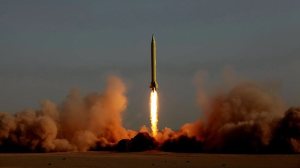By Greg Thielmann
 Iran tests a Shahab-3 during exercises in 2012. Photo Credit: AFP
Iran tests a Shahab-3 during exercises in 2012. Photo Credit: AFP
Ballistic missile limits continue to receive attention as a candidate for inclusion in the ongoing Iran nuclear talks – most recently in a hearing of the House Armed Services Committee on June 19. But making the case for inclusion ignores how seeking such limits could derail the negotiations.
The opening statement of Chairman Buck McKeon (R-California) included the complaint that "the largest ballistic missile arsenal in the Middle East" does not appear to be "within scope of a comprehensive deal." No member at the hearing challenged the notion that the deal should include limits on Iran's missiles. Indeed, Rep. Doug Lamborn (R-Colorado) asserted that it is the position of the U.S. House of Representatives that Iran must cease pursuing ballistic missile technology.
The witnesses at the hearing, however, were divided on how to address the issue. Michael Singh of the Washington Institute for Near East Policy, called for "insisting that Iran halt the development of missiles capable of carrying nuclear payloads." William Tobey of Harvard's Belfer Center for Science and International Affairs expressed the view that it was probably worth assigning priority to the nuclear weapons issues rather than attempt to create a grand bargain that would also include missiles.
The sentiments expressed by House members roughly parallel a provision in the draft Menendez-Kirk bill, sponsored by a majority of senators, which envisions imposing new sanctions on Iran if it conducted any tests for ballistic missiles with a range exceeding 500 kilometers.
It is obvious that Iran's ballistic missiles constitute both present and potential future threats to U.S. interests in the Middle East. Iran possesses in excess of a hundred short-range ballistic and cruise missiles, which can target shipping in the Persian Gulf, as well as military bases and cities in adjoining countries.
Iran has also deployed several dozen Shahab-3/Ghadr-1 and perhaps also Sejjil-2 medium-range ballistic missiles, which could reach other countries in the region, such as Israel. Inaccurate and armed with conventional warheads, such weapons are currently unsuitable for achieving militarily significant results, but they can be potent instruments of terror, revenge, and intimidation.
Iran itself felt the sting of ballistic missiles during its 8-year war with Iraq when Saddam Hussein's regime fired some 200 Scud-variant missiles at Iranian cities, killing an estimated 2,000 people and forcing many more to flee.
With an aging air force (long subject to embargoes and sanctions), dwarfed by those of likely opponents – not just that of the United States, but also of Israel with one-tenth of Iran's population – and completely outclassed by the military aircraft of Saudi Arabia and even smaller Gulf states like the UAE, Iran has a limited capability to project power.
Iran's active duty and reserve military is smaller than that of neighboring Turkey with a roughly comparable population. Iran's military expenditure (as a percentage of GDP) is around one-fourth the size of rival Saudi Arabia's. Iran has far less than half as many tanks as Egypt. Is it any wonder that Iran seeks to compensate for these order-of-battle deficiencies with missiles?
In terms of space and payload, any of these missiles capable of carrying 500 kilograms to a distance of 300 kilometers, could become a delivery vehicle for nuclear weapons. So effective missile limits to prevent Iran from developing nuclear-capable systems would have to prohibit Iran from flight-testing or deploying systems at or below the 500 kg/300 km threshold, gutting its conventional missile forces.
The Arms Control Association has previously suggested alternative approaches to addressing concerns over Iran's missiles outside of the nuclear negotiations and will elaborate further in the third edition of the ACA Briefing Book, "Solving the Iranian Nuclear Puzzle," to be released on June 26. But the best approach to curbing nuclear-capable missiles is to discourage Iran from wanting and being able to produce nuclear warheads in the first place. And that is exactly what the ongoing negotiations are seeking to do.
The success of the negotiations will be largely determined by whether or not the limitations on enrichment capability and the scope and intrusiveness of verification measures makes breaking out of the nuclear Non-Proliferation Treaty a sufficiently difficult and unattractive option for Tehran.
Trying to strip Iran of its ballistic missile arsenal in the nuclear talks would be a fool's errand, likely only to sabotage prospects for getting a grip on the issue that really matters.
